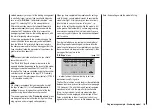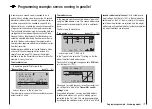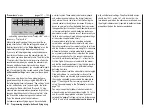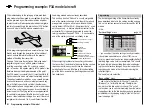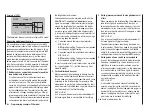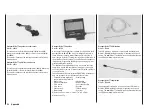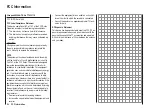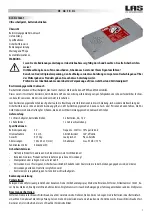
183
Programming example: F3A model
stick mode
motor at C1
1
tail type
normal
cut off
+150%
–100%
9
aile/flap
2aile
idle re.
The remaining settings should be adjusted as required
to suit your personal preferences.
You may find it necessary to assign transmitter controls
to particular inputs to operate the retractable undercar-
riage and carburettor mixture adjustment. This is carried
out in the …
“Transmitter control settings”
menu
For example, you may like to assign a particular trans-
mitter control - perhaps one of the ON / OFF switches
SW 2 or 8 - to the input “E8” for the retracts, and a rotary
proportional control - e. g. CTRL 6 - to the input “E7”, for
mixture adjustment.
I5
I6
I7
+
trv
I8
ctrl 6
free
free
8
+100% +100%
+100%
+100% +100%
+100% +100%
+100%
The retracts are extended and retracted when you oper-
ate the switch “SW 8”. You may need to adjust the travel
of the transmitter control, and perhaps reverse that
channel by setting a negative prefix for servo travel.
F3A models fly fairly fast, and respond very “solidly” to
corrective movements of the servos. However, in com-
petition flying it is vital that all abrupt control movements
model suddenly ballooning up.
A little down-elevator must usually be mixed in to ensure
that the aeroplane does not climb when the ailerons /
flaps are deployed.
To meet these requirements you need the two mixers
shown in the illustration below.
typ fro
to
M1
M2
M3
c1
el
c1
??
5
??
3
3
The mixers are activated using one and the same ex-
ternal switch, e. g. “SW 3”, which therefore has to be as-
signed to
both
mixers, with the same direction of effect.
Touch the central
SET
button of the right-hand touch-key
to move to the mixer inputs on the second screen page,
and set the appropriate mixer ratios. In both cases the
mixer neutral point should be left at the centre position
of the Ch 1 stick travel.
For this reason you should now move the Ch 1 stick to
the Idle range, select the
ASY
field, and enter the follow-
ing values:
MIX 1: -60% … -80% and
MIX 2: -5% … -10%.
and corrections should be kept to a minimum, as the
judges will invariably notice any lack of smoothness and
dock a few points, so it is advisable to set exponential
control characteristics on the stick functions.
Move to the …
“D/R Expo”
menu
Exponential values of 30% on aileron, elevator
and rudder have proved to be a good starting point, and
you can set them in the right-hand column of this menu.
These values provide smooth, well-defined control of
the typical F3A model. Many experts use higher values;
even up to +60% exponential.
100%
100%
100%
+33%
+33%
aile
elev
rudd
DUAL EXPO
–––
–––
–––
+33%
Since F3A models generally have two aileron servos, it
has proved useful to deflect both ailerons “up”
slightly
for
the landing. In most cases this causes the model to fly a
little more slowly and with a more stable attitude on the
landing approach.
To achieve this you will need to program mixers in the …
“Free mixers”
menu
(section starting on page 127).
Both ailerons are usually required to deflect “up” as a
landing aid, in parallel with the movement of the throttle
stick, but only from the half-throttle setting in the direc-
tion of idle. From that point on, the further the stick is
moved towards the idle position, the more the ailerons
deflect up. The reverse occurs when you open the
throttle: the ailerons are returned to neutral to avoid the
Summary of Contents for mx-12 Hott
Page 1: ...Programming Manual 33116 mx 16 HoTT 3 en mx 16...
Page 35: ...35 For your notes...
Page 49: ...49 For your notes...
Page 55: ...55 For your notes...
Page 59: ...59 For your notes...
Page 63: ...63 For your notes...
Page 69: ...69 For your notes...
Page 91: ...91 For your notes...
Page 101: ...101 For your notes...
Page 123: ...123 For your notes...
Page 181: ...181 For your notes...
Page 193: ...193 For your notes...

